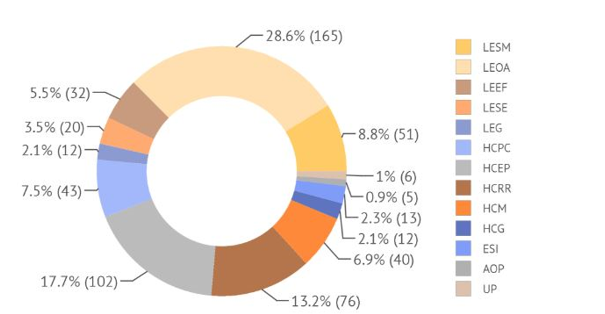About a quarter of the examined patent applications were published by the United States Patent and Trademark Office; the Chinese patent office is second by popularity with another 19% of published documents. These countries were also among the leaders of solar energy production in 2015. Nearly a third of the patent applications were published in regional patent offices: the World Intellectual Property Organization (17%) and the European Patent Office (17%). The diagram below represents the distribution of the top 10 patent offices in this collection of patent applications.
In recent years technologies for conversion of concentrated solar energy into electrical energy have demonstrated steady growth around the world. Namely, in 2015 global CSP capacity growth comprised 8.5%. Major technologies that are implemented in this industry are: Power Tower Systems, Parabolic Trough systems and Linear Fresnel Reflector systems. The development of these and other technologies to a great extent depends on patenting activities. However, in many cases it is not necessary for an inventor to limit implementation of their invention to certain types of technologies, which is why there are certain difficulties for a set of patent documents in terms of their attribution to one specific technology. The present review represents an analysis of patent applications that concern concentrating solar power in general, disclosing universal solutions for this industry without any clear specifications showing their applicability to some specific technologies. The review examines 305 applications published in 2015 in 23 patent offices.
Distribution of documents by patent offices
| Patent office | Number of documents | Share |
|---|---|---|
| United States Patent and Trademark Office | 72 | 23.6% |
| State Intellectual Property Office, China | 53 | 17.4% |
| European Patent Office | 47 | 15.4% |
| World Intellectual Property Organization | 46 | 15.1% |
| Japan Patent Office | 16 | 5.2% |
| National Institute of Industrial Property, Chile | 10 | 3.3% |
| Intellectual Property India | 9 | 3% |
| Korean Intellectual Property Office, South Korea | 8 | 2.6% |
| Israel Patent Office | 6 | 2% |
| Instituto Mexicano de la Propiedad Industrial | 6 | 2% |
| All other offices | 32 | 10.5% |
The chart below demonstrates the distribution of problems which the patent applications in the present collections are aimed to resolve. The data is presented in the form of quantity and share of documents concerning a specific problem.
IPC classes that were mentioned in the patent applications most of the time are those concerning the production and use of heat; optical elements, systems, or apparatus; and layered products, i.e. products built-up of strata of flat or non-flat, e.g. cellular or honeycomb, form (F24J, G02B and B32B, respectively).
Approximately half of the documents in the present collection are members of patent families, while the other half are individual documents or those which didn't have patent families at the moment of data collection.
In the capacity of technical solution about 85% of patent applications disclose, among others, hardware design, while 52% of documents include descriptions of methods and procedures, and 14% disclose substances and materials. The most popular combination of these types of technical solutions is the combination of method and device – nearly 35% of documents have indications of both simultaneously.
The most popular patent offices among non-residents are the USA, China, Europe, Chile and India. In such offices as Chile, India, Israel, Mexico, and Australia patent applications were only published by non-residents. The majority of applicants that published patent applications examined in the present collection reside in the USA, China, Japan, Germany, and Spain. Residents of these countries comprise about 70% of all applicants in the present collection of documents.

LESM - Low efficiency due to solar movement; LEOA - Low efficiency of optics or absorber; LEEF - Low efficiency due to environmental factors; LESE - Low efficiency of secondary equipment; LEG - Low efficiency in general; HCPC - High costs of plant construction; HCEP - High costs of equipment production; HCRR - High costs of repair and replacement; HCM - High costs of maintenance; HCG - High costs in general; ESI - Environmental and social impact; AOP - Administrative and organisational problems; UP - Unclear problem
28% of patent applications disclose solutions that to a great extent concern the optical devices used for sunlight concentration – mirrors, lenses, their shapes and configurations. 22% of the documents reviewed are related to receivers – devices that are dedicated to the conversion of concentrated solar radiation into one or another type of useful energy. 19% of applications describe solutions for solar tracking and aiming a heliostat in a respective manner.
In the majority of cases the authors of the patent applications mention the problem of low efficiency of transmission of energy from an optical device to a receiver. This problem also includes such aspects as the quality of optical device, its optimization or structure, as well as various types of energy losses at the moment of absorption of concentrated solar radiation by a receiver. About a third part of documents to some extent are aimed at resolving the problem of high costs of the equipment involved, while a quarter of documents concern the reduction of service and maintenance expenditures.
More detailed information on the methodology as well as on the results of patent researches in the most important fields of contemporary energy industry can be found on www.aenert.com
